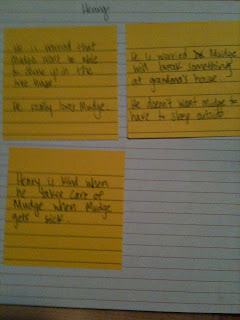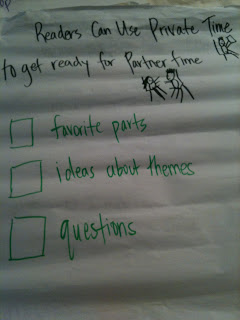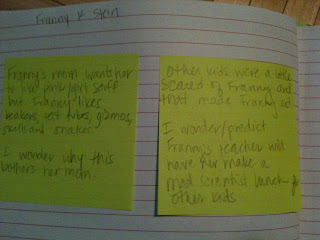In a nutshell, I have been asking kids, reading at level J and above, during reading conferences one or more of following questions:
- What ideas are you getting in your book right now?
- What do you think the author want to make you think or believe right now?
- How are you planning to keep track of your thinking in this book?
- What are you planning to share with your partner?
Please note, you can ask these questions of readers at lower levels but there may be other strategies you are concerned about as well.
The young readers and I have been inventing some really fun and exciting ways to keep track of their thinking, gather new ideas, and get ready for partner time. Here are some of the ways the kids can share. Please keep in mind this is NOT the only way to collect post-its to prepare for partner time. These are the ways kids invented after rereading their initial post-its and thinking about their books.
Let me show you some of these ideas up-close.
Collect post-its about characters and get ideas about the characters. First, invite kids to read a few books with the same character. After they finish reading a book or two, reread the post-its they have so far and ask, "What's the same about these jots?" Then, get an idea. Finally, read some more books with the same character with that idea in mind. See the example of this process below from Henry and Mudge.
Above: Post-its collected and then students reread them.
Below: Students developed this idea after asking themselves, "What's the same about these jots?"
Now they are ready to read on and look for places in other texts to support this idea.
Or, perhaps they will grow the idea or get a new one.
Collect post-it about the character's journey. Many realistic fiction stories or narrative nonfiction books are journeys. One way you can post-it is to read the blurb on the back of the book and/or the jacket cover to learn what the journey will be. Then, you can collect post-its to follow the journey. These post-its look like retelling post-its but they can help young readers accumulate text and talk about the main idea, the journey. They also support thinking about compare and contrast because usually the character does some changing by the end of the journey.
 |
| Above: Post-its to talk about the beginning of Amber Brown's journey. |
Last week a second grade told me that The Magic Tree House books were so great and she loved their predictable structure. She decided to turn to a clean page in her reading notebook and make a four column chart (across 2 pages of the notebook like the journey page above). She said, "Magic Tree House books always have the characters going somewhere. Then they have to get away or hide from an evil character, then they have to get something to bring back, and finally they have to escape." She proceeded to label her column with those 4 headings, "Going, Hiding, Getting, and Escaping." She decided she would begin by collecting post-its for each part to help her talk about the books with her partners. I hope I'll have a photo here for you soon!
The reason why I share this story, is because I want you to know that the ways I have shared above are not the only ways kids can collect jots. They can and should invent their own ways with you - especially ways that will help them do what readers at this level do:
Monitor for meaning in these longer texts.
Accumulate text while thinking about the main idea.
Make inferences about the characters and begin to develop ideas and then theories.
Consider author's intent and think about the big message of the text.
Happy reading and talking with your students!










